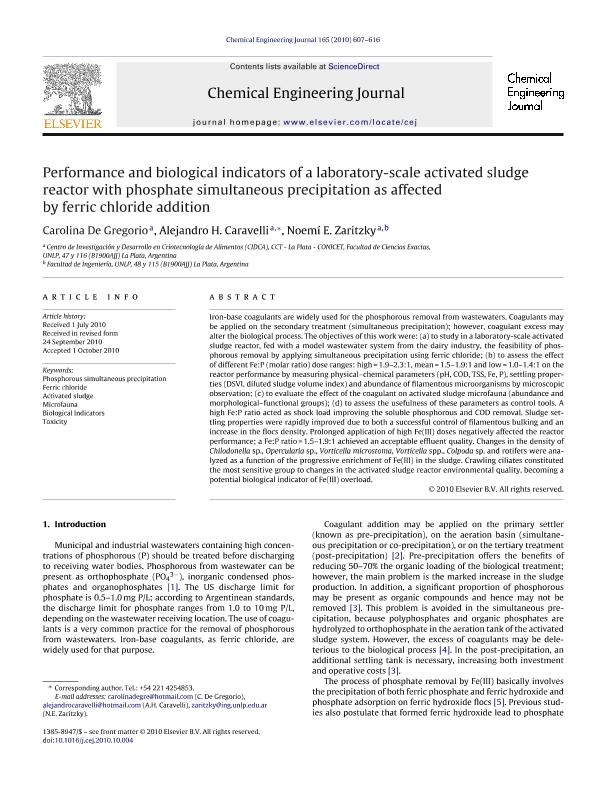Artículo
Performance and biological indicators of a laboratory-scale activated sludge reactor with phosphate simultaneous precipitation as affected by ferric chloride addition
Fecha de publicación:
12/2010
Editorial:
Elsevier Science SA
Revista:
Chemical Engineering Journal
ISSN:
1385-8947
e-ISSN:
1873-3212
Idioma:
Inglés
Tipo de recurso:
Artículo publicado
Clasificación temática:
Resumen
Iron-base coagulants are widely used for the phosphorous removal from wastewaters. Coagulants may be applied on the secondary treatment (simultaneous precipitation); however, coagulant excess may alter the biological process. The objectives of this work were: (a) to study in a laboratory-scale activated sludge reactor, fed with a model wastewater system from the dairy industry, the feasibility of phosphorous removal by applying simultaneous precipitation using ferric chloride; (b) to assess the effect of different Fe:P (molar ratio) dose ranges: high = 1.9-2.3:1, mean = 1.5-1.9:1 and low = 1.0-1.4:1 on the reactor performance by measuring physical-chemical parameters (pH, COD, TSS, Fe, P), settling properties (DSVI, diluted sludge volume index) and abundance of filamentous microorganisms by microscopic observation; (c) to evaluate the effect of the coagulant on activated sludge microfauna (abundance and morphological-functional groups); (d) to assess the usefulness of these parameters as control tools. A high Fe:P ratio acted as shock load improving the soluble phosphorous and COD removal. Sludge settling properties were rapidly improved due to both a successful control of filamentous bulking and an increase in the flocs density. Prolonged application of high Fe(III) doses negatively affected the reactor performance; a Fe:P ratio = 1.5-1.9:1 achieved an acceptable effluent quality. Changes in the density of Chilodonella sp., Opercularia sp., Vorticella microstoma, Vorticella spp., Colpoda sp. and rotifers were analyzed as a function of the progressive enrichment of Fe(III) in the sludge. Crawling ciliates constituted the most sensitive group to changes in the activated sludge reactor environmental quality, becoming a potential biological indicator of Fe(III) overload.
Archivos asociados
Licencia
Identificadores
Colecciones
Articulos(CIDCA)
Articulos de CENTRO DE INV EN CRIOTECNOLOGIA DE ALIMENTOS (I)
Articulos de CENTRO DE INV EN CRIOTECNOLOGIA DE ALIMENTOS (I)
Citación
de Gregorio, Carolina; Caravelli, Alejandro Horacio; Zaritzky, Noemi Elisabet; Performance and biological indicators of a laboratory-scale activated sludge reactor with phosphate simultaneous precipitation as affected by ferric chloride addition; Elsevier Science SA; Chemical Engineering Journal; 165; 2; 12-2010; 607-616
Compartir
Altmétricas




